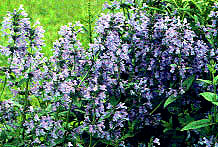RENEGADE GARDENER™
The lone voice of horticultural reason
Nepeta
(NEP-e-tuh)
Common name: Catnip
 Airy and graceful, catmints bring such a refined touch of elegance to the landscape that one would think they must have some hidden drawback – you know, hard to grow, invasive as quack grass, favored by deer – but no! Catmints are easy to grow, know their bounds, and are on everyone’s list of deer-proof perennials.
Airy and graceful, catmints bring such a refined touch of elegance to the landscape that one would think they must have some hidden drawback – you know, hard to grow, invasive as quack grass, favored by deer – but no! Catmints are easy to grow, know their bounds, and are on everyone’s list of deer-proof perennials.
Plus they work well in a wide variety of places. They look great busting up the front of the border, stand out in the middle of the bed, and the taller varieties hold their own at the back. I particularly like catmint tumbling out from the front into pathways.
Foliage is a major reason to experiment with this perennial. Leaves, depending on variety, are a pubescent silvery-gray. Coupled with the tiny twists of tubular flowers, a mint-like aroma, and four-sided stems, catmints are a distinctive addition to the northern garden.
 |
| Nepeta sibirica ‘Souvenir d’Andre Chaudron’ syn ‘Blue Beauty’ |
There are half a dozen varieties commonly found in the northern trade. Most popular are ‘Blue Wonder,’ which reveals rich lavender-blue flowers for a relatively long period of time (up to five weeks) in mid-season. It grows between 12 to 14 inches tall and will rebloom if sheared. N. sibirica ‘Souvenir d’Andre Chaudron’ is the current favorite in the Twin Cities, and deservedly so. It grows quite vertically up to 3′ tall and blooms profusely. N. subsessilis is a Japanese species that looks like a shorter version of ‘Chaudron.’ Also reblooms when sheared.
‘Six Hills Giant’ is the tallest variety, turning into a 3′ x 3′ shrub-like bush by season’s end. Blooms lavender-blue for a month or more mid-season. Won’t rebloom when sheared, but it looks neater for the rest of the season.
Care and Use
Catmints prefer full sun but are worthwhile in areas where they will receive at least four hours of direct, midday sun. Organic content of soil is not as important as that the soil be well drained. Fertilize twice per season (mid-May and the end of June) for maximum fullness and bloom. Shear the plants after first flowering for appearance and, in some cases, rebloom.
Once established they do become fairly drought-tolerant. All hardy to Zone 4, ‘Six Hills Giant’ reliably to Zone 3.
Don Engebretson
The Renegade Gardener